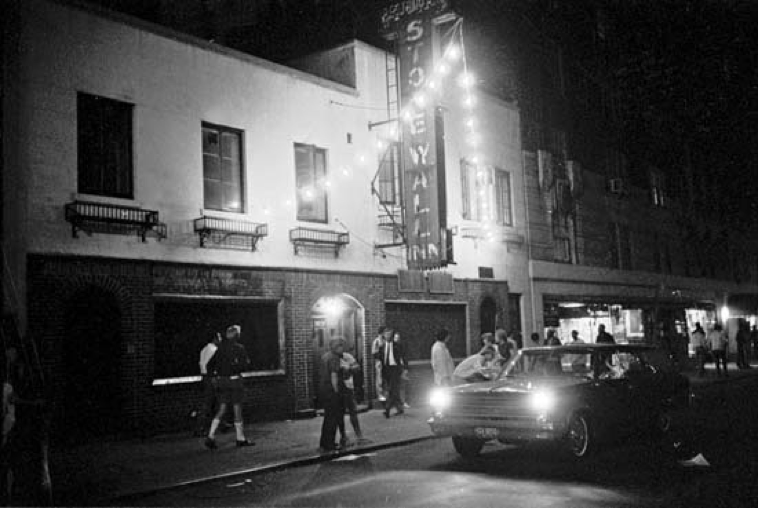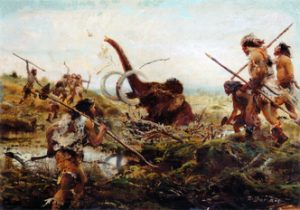Forced to retreat into the very establishment in which they were running people out off, the fearful and injured eight detectives were able to push and create a path for themselves. Once inside, they boarded the doors of the Stonewall Inn and called for backup. At the moment, the bar served as their only protection from the angry rioters outside. Before they knew it the Stonewall Inn, ironically their only sanctuary at the moment, was breaking. Windows around them were shattering and Molotov cocktails were thrown in. Flames, although not very strong, began to build around them.1 Soon after, the front door was broken down leaving the detectives exposed and vulnerable. One would agree that feelings of dread, lonesomeness, and hopelessness were the emotions that filled the detectives, as would anyone in their situation. However, these were familiar everyday feelings that the rioters outside had long felt. But how did we get to this moment?

On the hot summer day of June 28, 1969, a rather morbid atmosphere filled the air of the Stonewall Inn as people were mourning the recent death of Judy Garland, a popular actress known for her role as Dorothy in The Wizard of Oz. She was greatly adored in the gay community.2 Sadly, the gay community could not say that they felt any adoration or appreciation as Garland was receiving. What they felt was quite the opposite. This is why many gays frequented the Stonewall Inn. The Stonewall Inn, located in Greenwich Village, a neighborhood of Manhattan, New York, was a home to many homosexual individuals, as they could gather there free of social and political judgement. Outside of their safe haven, all hid their true identities and selves, putting on a façade for others to see. When some men were “outed” or labeled as being as homosexual, only true hell was to follow, with no light at the end of the tunnel. Homosexuals were treated as abominations by strangers, their own families, and even the law. The year 1952 marked the establishment of the McCarran-Walter Act. This act was a revision to an existing immigration law that allowed one to be deported, or to be denied entry to the country if one were a “psychopathic personality.” Conveniently, a homosexual fitted the profile of a psychopathic personality in the eyes of the law. Homosexuality was even treated as a mental disease at this time. Arrested homosexuals were often sent for psychiatric evaluation, and most were found as having psychotic tendencies and personalities. Psychologist and psychiatrist would perform counseling and treatments in order to “cure homosexuals and revert them back to their original state.” There were even extreme cases in which lobotomies were performed on homosexual individuals. However, people believed that science wasn’t the only method of treating homosexuality. The other treatment was religion and prayer. American church congregations had been taught to believe that homosexuality was a form of sin and that the devil was to blame. In order to rid oneself of sin and these temptations, one could “pray the gay away.” Although not to the same degree, we still see both these problems today, especially within the church. In 1969, one could even find themselves on the front page of the newspaper, shamefully describing their sexual orientation. Soon after, they would lose their job, insurance, credit, and family. Homophobia doesn’t discriminate, and all these problems were also known to effect homosexual women as well.3

The Stonewall Inn was also a popular spot where many came to illegally drink and dance. Bisexuals and drag queens also frequented the bar. At this time in the United States (1969), much like it is in current day Russia, it was illegal to cross dress, dress as a drag queen, and serve alcohol to homosexuals. These “laws” were constantly being broken; so, police would perform frequent raids on bars that they suspected of housing gays and ones that they thought were illegally serving alcohol without a license.4 On this specific night, the police obtained a warrant and were scheduled to perform a routine raid on the Stonewall Inn at around 2:00 AM, when the people inside would least expect it. The officers believed they were adequately prepared as no serious problems or resistance were known to occur when homosexuals were involved. Little did they know they were in for a rude awakening. As they barged into the bar, two bright-white lights flashed on the dance floor, a well-known signal within the gay community. This indicated to everyone that the police were present. Immediately, the eight detectives demanded for everyone to leave the bar, including the staff, and line up outside with their identification. The people inside, though angry and irritated, followed the orders given to them. With individuals lined up against the Stonewall Inn outside, a police wagon then pulled up, opened, and officers then began to arrest multiple drag queens, people without proper identification, and staff. As people were being detained, enraged onlookers yelled “Pigs,” “Abuse of Power,” and “Police Brutality” to the detectives. An uproar then followed. No one knows today who exactly started the riots, but one can agree that the community finally snapped. The years of abuse, the treatment directed to Lesbian, Gay, Bisexual, Transgender, and Queer (LGBTQ+) individuals, and the fact that they were to be arrested for being who they were, finally lead up to that moment. That was the moment when they had had enough. And at this moment, multiple people reported that a drag queen escaped from the hands of one of the detectives, turned around, and punched them in the face. This one punch would be responsible for starting a revolution.5
This action triggered almost everyone involved to begin throwing bottles, stones, and other objects at the detectives and their vehicles. As you can imagine, things only escalated from there, leading the police then to run back into the bar for shelter. Rioters managed to break off a parking meter and began to beat the door of the Stonewall with it. Once that shelter was breached, drag queens and homosexual men threw punches at the police as the police threw punches at them. Quickly word spread through the city and hundreds of onlookers, mostly from the LGBTQ+ community, gathered outside the bar. The uproar then continued to grow tremendously.

When reinforcements arrived, more specifically the Tactical Patrol Force, they fought head-on with all the rioters. The Tactical Police Force were dressed in helmets with visors and were in body armor. They also yielded tear gas, riot shields, and other weapons. The Tactical Police Force linked arms and attempted to sweep the streets clear of people but they inevitably failed. Their numbers were small compared to how many rioters were present. From this, they had no other choice but to charge into the crowd. Men and women were brutally clubbed to the ground, and police force members were injured from different objects being thrown and blunt force from rioters. It wasn’t until after 4 AM, that the police were officially withdrawn.6 However, the riots did not end. Some rioters were arrested and charged with assault, resisting arrest, selling alcohol without a license, harassment, and for many other reasons. Even after the withdrawal of the police, people roamed the streets and continued to gather together chanting their opinions on the police and everyday people.

The Stonewall Riots continued for days to come and grew more violent with each day. Once Greenwich Village was settled and calmer, many visited the Stonewall Inn to see the damage that was left as a result. Streets were filled with trash and graffiti was drawn on the Stonewall Inn with slogans stating, “Legalize gay bars.” Word spread across the United States of how LGBTQ+ members were tired of being oppressed and segregated, and how they would use violence if necessary, in order to be treated as equals. These riots, a foundational event, sparked many LGBTQ+ movements, gave people the confidence to oppose the government, and gave them the courage to demand that they be treated as humans and not as scoundrels. Slogans such a “gay power” and “homosexuals are human too” began to appear. In the following month of July, organizations that focused on the empowerment of gay individuals were established. The first is known as the Gay Liberation Front (GLF). Although, there are still problems being faced today within the LGBTQ+ community; such as transgendered rights, the Stonewall Rioters were key factors in their movement up the social and political ladder.7 What took place at the Stonewall Inn is a story that isn’t commonly shared or taught in history books or classes today. Regardless of the fact that the people directly involved are homosexual individuals, history is history, and it should be shared so that we are not doomed to repeat ourselves.
- Walter Frank, Law and the Gay Rights Story (New Jersey: Rutgers University Press, 2014), 32-39. ↵
- Encyclopedia of Lesbian, Gay, Bisexual and Transgendered History in America, 2004, s.v. “Stonewall Riots,” by Fred Wasserman. ↵
- Walter Frank, Law and the Gay Rights Story (New Jersey: Rutgers University Press, 2014), 22-31. ↵
- Encyclopedia of Lesbian, Gay, Bisexual and Transgendered History in America, 2004, s.v. “Stonewall Riots,” by Fred Wasserman. ↵
- Encyclopedia of Lesbian, Gay, Bisexual and Transgendered History in America, 2004, s.v. “Stonewall Riots,” by Fred Wasserman. ↵
- “4 Policemen Hurt in ‘Village’ Raid,” The New York Times, 29 Jun. 1969. ↵
- Scott Bravmann, “Stonewall, Silver Screen: Cinematic Representation and the Queer Past,” American Quarterly 48, no. 3 (September 1996): 491-499. ↵



74 comments
Rafael Azuaje
There is a long history of oppression towards those who don’t “fit in”. I did a little research on this, and a couple things stood out to me. In 1912 in Portland, Oregon, while being interrogated, a young shoplifter revealed a gay male subculture. Around 100 men were implicated, and 60 charged with sodomy in this scandal. It even led to a law passed in 1917 that authorized sterilization of “sexual perverts” and “moral degenerates”. The US armed forces after World War 2 invented the “blue discharge” to be used to separate service members who were gay or bisexual. The blue discharge was neither honorable or dishonorable. If a person received this type of discharge they were ineligible for the GI Bill.
Michelle Falcon
This for me was an eye opening article. I have always know that it was never easy, especially in the past, to be apart of the LGBTQ+ community but I never knew how hard it was until reading this article. It is crazy to thing that it’s still like that in other parts of the world, such as Russia, still to this day. Over all this was a great article that I’m glad I had the opportunity to read.
Manuel Aguilera
I like how the author created irony in the fact that it was initially from the detectives’ perspectives but then went on to switch it around. I find it very sad that people of different sexualities had to face such harsh environments in the past. It also embraces the upbringings of anti-LGBTQ foundations as it was not something initially present in American History.
Megan Barnett
The introduction really did catch my attention as I guess I never knew the story of what exactly happened at that the Stonewall Inn during the Stonewall riot, so I was confused as to why the detectives needed protection. I am still a little confused on why Judy Garland was an icon for the gay community and why that information played a role in this story, other than that good job at staying on topic and including information that was relevant.
Josemaria Soriano
Really an awesome introduction. It draws attention because it describes the drama of the exact moment of the conflict, without giving explanations, which causes curiosity and intrigue to the reader. Very good literary resource. On the subject: I believe that this story is a clear example of the power of hope and union. It seems impossible to have a fight between the LGBT community and the police as the winner, but that was the case. And this is because of the power of the union, which overcomes any intimidation. Throughout history this plot has been repeated countless times. We see how a minority and excluded group begins to fight for their rights, and the first action of the government or power groups will be to segregate and intimidate. But only those who prevailed in the fight ignoring all kinds of intimidation, will be those who end up to validate their rights. Let us take the example of the LGBT community, who was silent and embarrassed for centuries of their condition, until they were fed up and they rebeled against any marginalization. Many thought that it was a crazy impossible task, a waste of time to think that one day the United States would be an inclusive country with the homosexual community, but nowadays it is not only a reality, but the United States is the country where homosexuals can count on the “American dream”.
Teresa Valdez
Amazing introduction. It really caught my attention that the introduction was from the point of view of the police officers, but the article went on to talk about the empowerment of the LGBTQ+ community. The background information, though understandably necessary, put a little stall in the narrative in this article, but overall it is a great piece. Americans do not like to remember the oppressive manner in which they treat a number of minority groups, so I really liked the comparison to Russia, reminding us that it was not long ago that our country treated LGBTQ+ people so badly. There is still a long way to go towards equality but this well researched article displays the contrast between then and now well. Great article!
Mariah Cavanaugh
Stonewall is such a pivotal moment in the history of LGBTQ+ rights. It is so important to remember that this uprising included the entire spectrum of the LGBTQ+ community, including people of color. When this story is told it tends to be whitewashed and only include those who identified as gay and lesbian. They did this in the movie stonewall that was released in 2015. I appreciate the fact that you included the entire community and the part they played.
Alondra Aviles
This experience is one that the Gay community should never have to endure again, yet it is fatal that it still happens today. The riot very much reminded me of the Orlando shooting; tragic event that continues to negatively impact people. The article correctly expressed the fear among those who were in this event and how it should serve as a lesson. The LGBTQ+ community continues to endure segregation and I believe that, after reading this article, the violence should really be more regarded against these individuals. This article could shed light to current events and should be considered a very important and impactful historic moment.
Clarissa Bustamante
This is such an amazing article! I love how you started off with the conflict occurring because it just caches the readers attention a whole lot faster. It’s amazing how this article was set up and how it tells you why and how the riot began. I hope that a day comes where everyone accepts the fact that some people are of all sex orientations.
Samuel Stallcup
Anti-LGBT history is incredibly important in the context of U.S. history. I liked how you were able to construct this very scary event, and its meaning for the LGBT community. I had also previously never heard of this event, for I don’t really know the history other than the constant hatred both before and now. I feel that this event led up to the recent events, such as the LGBT community being able to legally marry in the United States, and this may have been the stepping stone in building up this community.